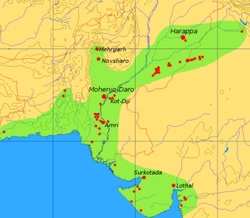Events


- c. 2900 BC–2334 BC: Mesopotamian wars of the Early Dynastic period continue.
- c. 2400 BC–2000 BC: large painted jar with birds in the border made in the Indus River Valley civilization and is now at Museum of Fine Arts, Boston
- 2400 BC–There is archaeological evidence that the site of Assur was occupied at around this time.
- c. 2360 BC: Hekla-4 eruption.
- c. 2350 BC: The 2350 BC Middle East Anomaly (apparent comet or asteroid impact) happened.
- c. 2350 BC: End of the Early Dynastic III period in Mesopotamia.
- c. 2350 BC: Lugal-Zage-Si of Umma conquers Gu-Edin and unites Sumer as a single kingdom.
- c. 2350 BC: First destruction of the city of Mari.
- c. 2345 BC: End of Fifth Dynasty. Pharaoh Unas died.
- c. 2345 BC: Sixth Dynasty of Egypt starts (other date is 2460 BC).
- c. 2350-2300 BC: pharaohs Teti, Userkare reign, Pepi I then rules into the 23rd century BC.
- c. 2340 BC–2279 BC: Semitic chieftain Sargon of Akkad's conquest of Sumer and Mesopotamia.
- c. 2334 BC: Sargon of Akkad establishes the Akkadian Empire. His dynasty fell in c. 2154 BC.
- 2333 BC: Dangun establishes Gojoseon, the first Korean kingdom, according to Korean mythology.